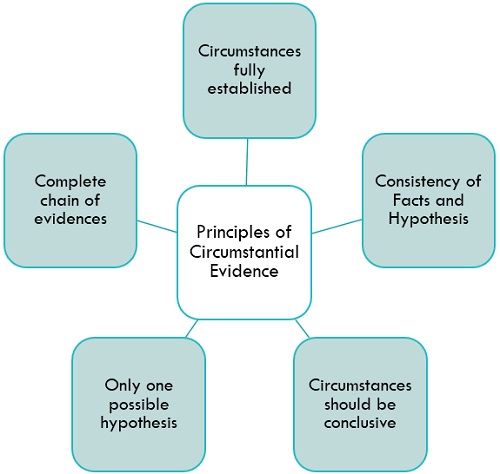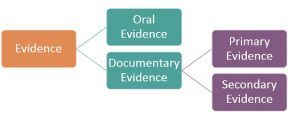 Evidence plays a crucial role in determining the facts and circumstances of the case. Without it, one cannot prove the offence committed by the accused, which makes the judgment impossible. To find out the facts of the case, we have two types of evidence, i.e. direct evidence and circumstantial evidence. Direct evidence refers to the evidence which when held as true by the Court, outrightly proves the fact.
Evidence plays a crucial role in determining the facts and circumstances of the case. Without it, one cannot prove the offence committed by the accused, which makes the judgment impossible. To find out the facts of the case, we have two types of evidence, i.e. direct evidence and circumstantial evidence. Direct evidence refers to the evidence which when held as true by the Court, outrightly proves the fact.
On the contrary, Circumstantial Evidence, as the name suggests, is the evidence, based on circumstances or incidents, which does not directly prove a fact, but it points out the guilt of a person indirectly, by linking the chain of events to reach the final conclusion.
In the eyes of law, both direct evidence and circumstantial evidence are given equal weight and importance. So, it is up to the jury on which one to believe and consider to establish the guilt of the accused beyond a reasonable doubt. Now, first of all, let us have some basic knowledge of the evidence.
What is Evidence?
Evidence is the clue, that helps us to find out the truth. It can be a physical object, a statement, document, deductive reasoning, supposition, or inference. It is submitted to the court or judge for the purpose of inspection.
This post will update you with all the facts and differences between direct evidence and circumstantial evidence.
Content: Direct Evidence Vs Circumstantial Evidence
Comparison Chart
| Basis for Comparison | Direct Evidence | Circumstantial Evidence |
|---|---|---|
| Meaning | Direct Evidence implies the evidence which confirms a fact and in which the inferences of the jury is not required. | Circumstantial Evidence refers to the evidence wherein the jury has to draw inferences based on the facts obtained linking it to the conclusion. |
| Based on | Personal knowledge of the witness or observation of the fact. | Fact from which existence or non-existence of another fact can be reasonably inferred. |
| Uses | Facts in issue | Series of related facts |
| Provability of guilt | When the judge is satisfied with the evidence beyond reasonable doubt of the defendant's guilt. | When the evidence does not directly prove guilt but brings about an inference of guilt, which is beyond a reasonable doubt. |
| Reliability | Less | Comparatively high |
| Suppression | Easy to suppress | Difficult to suppress |
| Inference or Presumption | Not required when proved. | Required to prove |
Definition of Direct Evidence
The evidence in which witness outrightly affirms about the fact in issue, which requires to be proved or disproved, depending on the claims he/she makes as to what is seen, heard, or felt by him/her at the time when the crime took place. It is one such evidence that does not require other evidence. Also, inferences or conclusion is not required to be drawn.
- It is fact-based evidence that indicates that the accused has committed the crime, beyond any doubt.
- It acts as a basis in many civil and criminal cases.
- It depends on the personal knowledge or understanding of the witness who gives their testimony.
For example, It can be in the form of:
- Testimony of witnesses
- Oral/written account of an eyewitness.
- Victim’s first-hand statement
- Confession made by the accused
- CCTV footage
Though direct evidence has an upper hand over circumstantial evidence, its reliability is generally questioned because the statement made by eyewitness may be false or based on a lie, which can easily mislead the Jury.
However, there is a general rule which says, the more direct evidence obtained, the stronger will be the case.
Also Read: Difference Between Primary Evidence and Secondary Evidence
Definition of Circumstantial Evidence
Circumstantial evidence is proof of multiple facts, which helps you to reach a final conclusion. It is one in which the witness does not explicitly affirm the facts of the case that is to be proved or disproved, rather evidence in relation to other facts is presented and then the inferences can be drawn based on logical reasoning.
- It is typically physical evidence.
- It tends to connect the suspect and crime scene or the victim of the crime.
- It requires an indirect inference to be made by the Jury, as to what happened.
In this, a single piece of evidence is not considered enough, as multiple pieces of evidence are required to prove the guilt of the accused. For this the jury is asked to link all the events and facts collected against the accused, to reach the conclusion. Also, there are possibilities of one or more explanations or conclusions.
For Example
- FingerPrint at the murder weapon
- Belongings of the accused at the spot where crime took place
- Blood or DNA samples
- Foot Print
Principles of Circumstantial Evidence
Five Basic Principles of Circumstantial evidence which constitute ‘Panchsheel‘ are:
- Circumstances on which inference or conclusion is based should be fully established.
- Facts that are established needed to be consistent with the hypothesis of guilt. Meaning that there is no other possible explanation of the hypothesis.
- The nature of circumstances should be conclusive, i.e. beyond a reasonable doubt.
- There is no other possible hypothesis, other than the one proved.
- There has to be a complete chain of evidence, that does not leave any room for doubt that the accused is innocent, in the sense that it must prove that the act has been performed by the accused only.
Also Read: Difference Between Acquittal and Discharge
Key Differences Between Direct and Circumstantial Evidence
So far we have discussed, the basics of the two types of evidences, now its time to talk about the differences between direct and circumstantial evidence:
- Direct evidence is one that signifies the commission of the offense by the accused in an explicit manner. On the contrary, Circumstantial evidence is one that suggests the background or factors, of the commission of the alleged offense, rather than actually proving it.
- Direct evidence relies on personal knowledge and perception of the witness presented or observation of the fact. As against, circumstantial evidence depends on the fact from which the existence or non-existence of another fact can be reasonably inferred.
- Direct evidence either proves or disproves facts in the issue, whereas circumstantial evidence relies on a series of facts, directly associated with the fact in the issue, that results in a cause and effect relationship to reach a conclusion with an explanation.
- In the case of direct evidence, if the judge is satisfied with the evidence beyond reasonable doubt of the defendant’s guilt, then the guilt is proven. As against, when we talk about circumstantial evidence, if the evidence does not directly proves guilt but brings about an inference of guilt, which is beyond a reasonable doubt, the guilt of the accused is proven.
- While direct evidence is regarded as more powerful evidence than circumstantial evidence. However, when it comes to reliability, effective and successful criminal prosecution mainly relies on circumstantial evidence. This is because the testimony of eyewitnesses can be false or misleading.
- In a direct evidence, no inference, presumption, or reasoning is required to prove the fact. As against, in case of circumstantial evidence, the same is needed to prove the existence of a particular fact.
- When it comes to suppression of evidence, circumstantial evidence is quite difficult to suppress, whereas direct evidence can easily be suppressed or fabricated.
Example
Direct Evidence
- Suppose a person stolen the precious gold jewelry and cash from Mr. B’s house, when they were not in the town. There are several surveillance cameras installed in Mr. B’s house, in which Mr. C was captured stealing the items. So, the CCTV footage will amount direct evidence.
Circumstantial Evidence
- Suppose a person stolen precious gold jewelry and cash from Mr. B’s house, when they were not in the town. Someone from the neighborhood saw Mr. X entering the house, on the date of the theft and coming out with a bag. The statement of the neighbour will amount to circumstantial evidence.
Conclusion
So, direct evidence proves a material fact or fact in issue on its own, whereas circumstantial evidence does not prove the material fact or fact in issue on its own.
Many a time, circumstantial evidence is used in conjunction with the direct evidence, as the former is considered as ineffective when considered alone.






Bea Furtado says
Very nicely put!